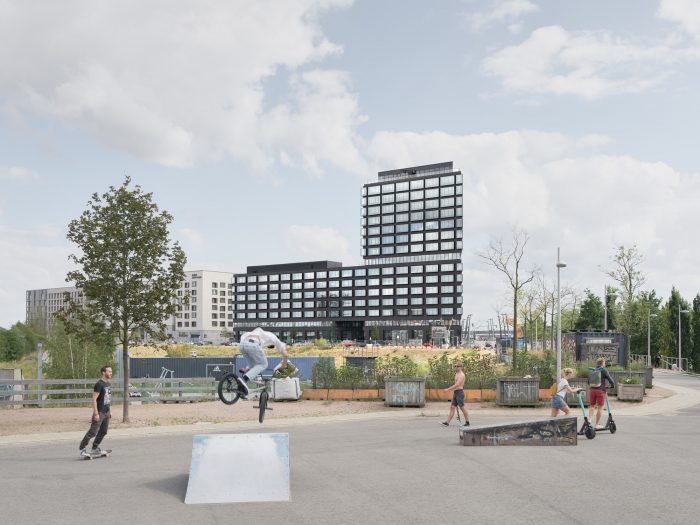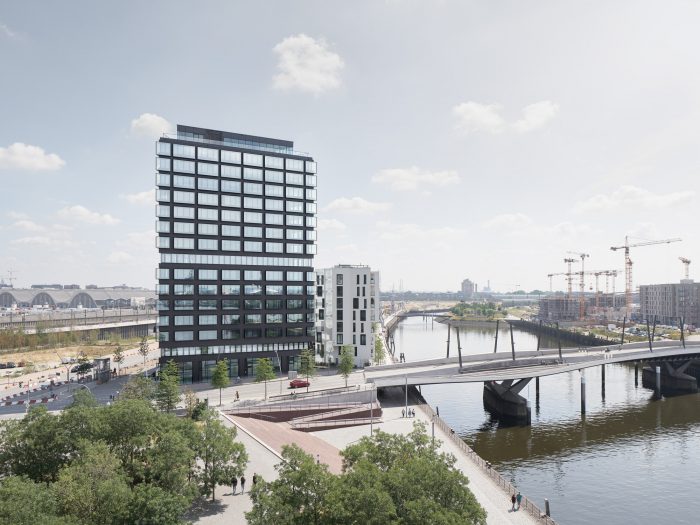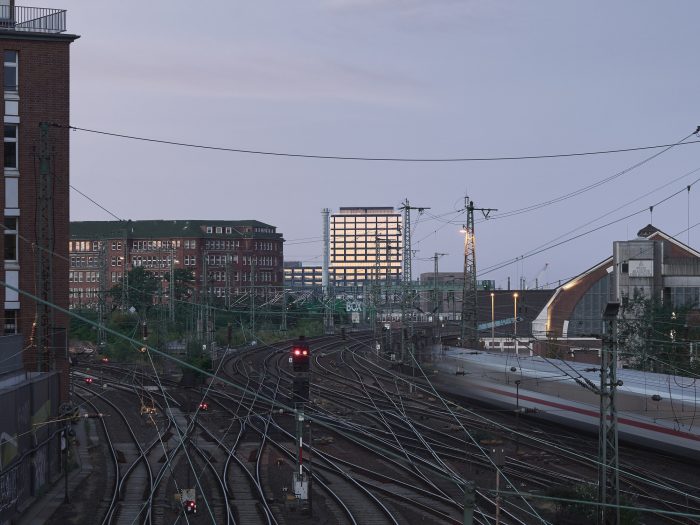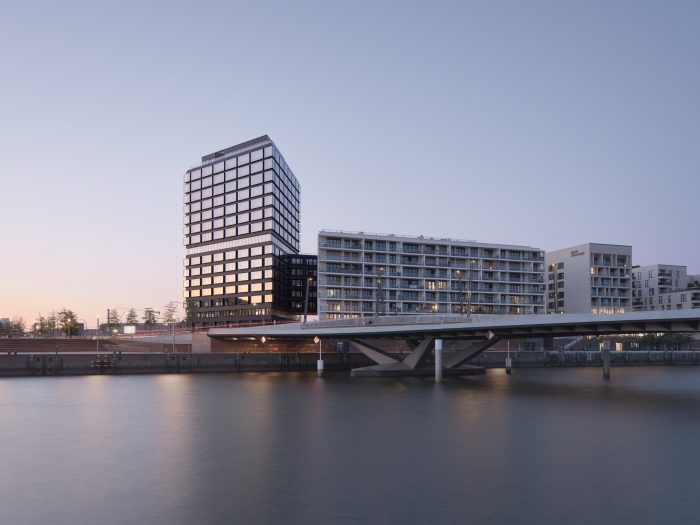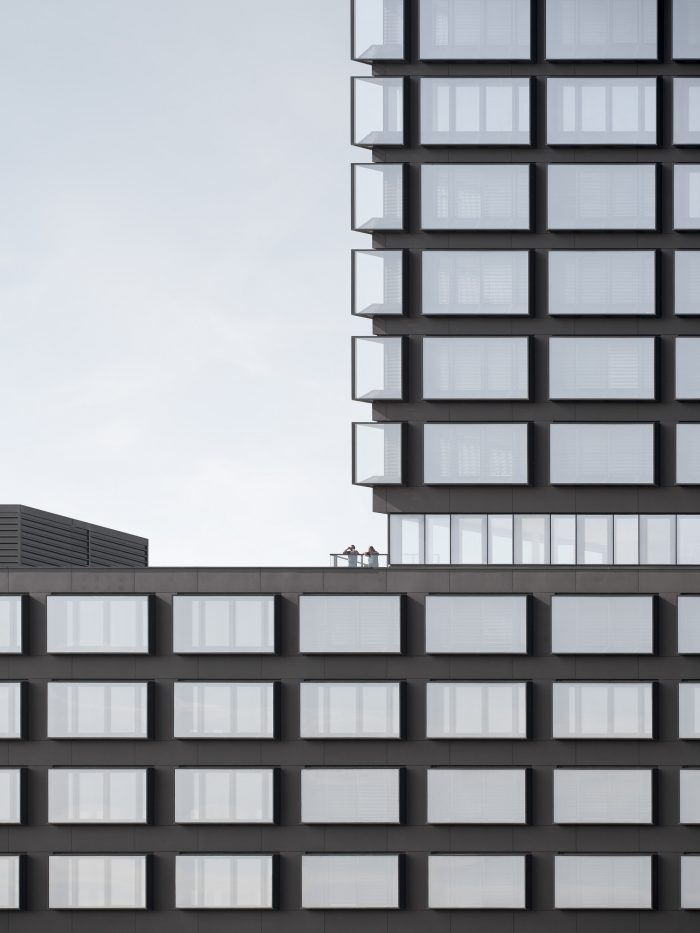办公楼被分为三个部分,这三个部分是由背景参数决定的:一个拱门、一个墙体和一个墙头。这种分割一方面为整个建筑群创造了强烈的特征,作为Baaken- hafen发展的城市化前奏,另一方面在建筑内部产生了城市品质。结构 特殊的功能,如一楼的启动办公室和HCU办公室,七楼的屋顶露台与办公和会议区相连的通道,以及在楼顶和棚顶之间360度视野的酒吧,都位于建筑的分界线内。
The office building is divided into three parts, which are determined by the means of contextual parame- ters: an architrave block, a waler and a head. This partition creates on the one hand a strong identity of the whole ensemble as an urbanistic prelude for the development of the Baaken- hafen, on the other hand generates urban qualities inside the building. Structure Special functions, such as the Start Up and HCU offices on the first floor, the access to the roof terrace with a connected office and meeting area on the seventh floor as well as a bar with a 360° view between the head of the building and the shed roof are located within the breaks sub- dividing the building.
同时,塔头的沉降形成了一种灯塔效应,辐射到远处,从而保证了远处的地标效应。两种材料塑造了办公楼的外貌。不透明区域用深色混凝土板铺设;半透明区域设计为外向型区域,通过导流板完成。这种解决方案既满足了防噪音的要求,又因窗户而产生了开放感。外部遮阳板位于导流板和隔热壳之间,因此可以防止风和天气的影响。
At the same time, the settling out of the head of the tower creates a sort of beacon effect radiating far beyond the bor- ders of the property, thus guarante- eing a landmark effect from afar. Two materials shape the outer appea- rance of the office building. The opaque areas are wainscoted with dark concrete slabs; the translucent zones are designed as extroverted areas, which are concluded through deflector panes. This solution accom- modates the requirements of noise protection, while allowing for a sense of openness thanks to the windows. The external sunscreen is positioned between the deflector panes and the thermic shell and is therefore protected from wind and weather influences.
外立面的图案与建筑的内部结构相一致;柱子和栏杆区域的不透明元素在顶部被减少。因此,这种措施创造了一种自成一体的优雅,以及附加值和更高层次的更好的视野,同时提供了一个经济有效的解决方案和透明与不透明材料之间的合理比例。外立面的结构在底层延续了大尺度的窗户,与不透明的正面相连。位于屋顶的360°酒吧使人们与Hafen-城市、Baakenhafen以及汉堡市中心形成了不同的视觉关系。由于棚顶向外缩减,以及镜面的屋檐,形成了一个花丝状的立面;晚上从街上可以看到建筑内的活动。
The pattern dividing the façade follows the inner structure of the building; the opaque elements in the area of the pillars and the railing are reduced at the top. In consequence, this measure creates a self-contained elegance as well as an added value and a better view for the higher levels, while at the same time offering a cost effective solution and an energetically reasonable proportion between the transparent and the opaque materials. The structure of the façade carries on at the ground floor with large scale windows, which are connected to the opaque front. The 360° bar located on the rooftop enables diver- sified visual relations to the Hafen- city, the Baakenhafen, as well as to Hamburg’s city centre. A filigree elevation is created thanks to the shed roof reduced towards the exterior as well as its mirrored soffit; the acti- vities within the building are visible from the street in the evenings.
建筑师:Delugan Meissl Associated Architects
面积:21154平方米
年份:2020年
照片:Piet Niemann
项目经理:Sebastian Brunke
项目组:Gerhard Gölles, Alejandro Carrera, Bogdan Hambsan, Michael Lohman, Petras Vestartas
执行规划:Gruppe GME
结构工程师:Schüßler Plan
HVACR:ZWP Ingenieur-AG
门面:朗格工程有限公司
消防:IBP
城市:Hamburg
国家:德国
Architects: Delugan Meissl Associated Architects
Area: 21154 m²
Year: 2020
Photographs: Piet Niemann
Project Manager:Sebastian Brunke
Project Team:Gerhard Gölles, Alejandro Carrera, Bogdan Hambsan, Michael Lohman, Petras Vestartas
Execution Planning:Gruppe GME
Structural Engineer:Schüßler Plan
HVACR:ZWP Ingenieur-AG
Facade:Lange Ingenieurgesellschaft
Fire Protection:IBP
City:Hamburg
Country:Germany


